Plenty To Worry About
It has been three weeks since I last updated these pages, and as I leaf through my charts, I am tempted to conclude that nothing substantial has changed. In the global economy, headline leading indicators signal stable and relatively robust growth. The first chart below shows that my diffusion index of macroeconomic leading indicators is rising gently, indicating that the pace of industrial production growth in the major advanced economies will rise to slightly above 4% year-over-year in the next few months. The two following charts show individual leading indicators in the large economies. They are all rising year-over-year, and momentum has accelerated, with the notable exception of the U.K's leading index still stuck below zero. Finally, I throw in charts of real M1 growth—arguably the best single macroeconomic leading indicator—and these data also are constructive. We have to watch the slowdown in China, but M1 growth rose in July, which does not suggest a liquidity crunch, at least not in Q3.
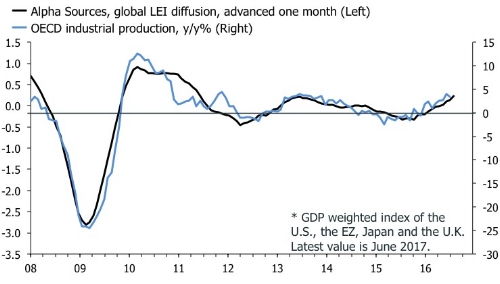
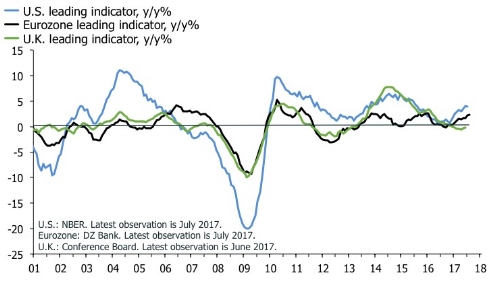
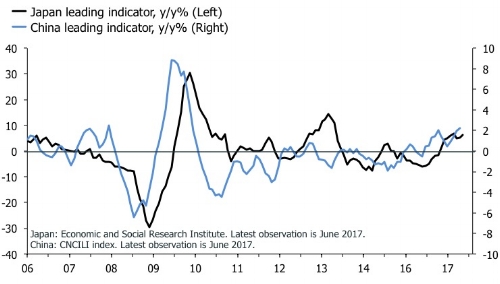
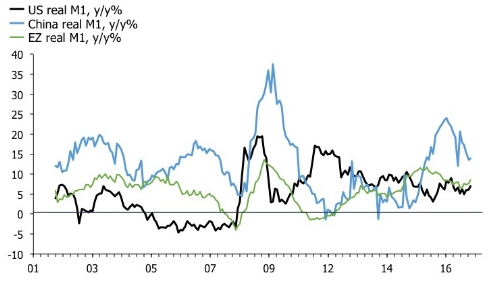
Except for the U.K., my reading of the major economies is that growth is more or less steady at a robust, but not record-breaking, pace. I think Simon Ward is correct in pointing to a resilient outlook for late 2017 and the beginning of next year. But he accompanies his call with a warning;
Six-month growth of global real narrow money* continued to strengthen in June, signalling a likely pick-up in economic momentum in late 2017 / early 2018, after a modest near-term slowdown. Monetary acceleration suggests that major central banks are falling further “behind the curve” and will be forced to tighten policies significantly as economic growth and inflation rebound.
I agree that we will see shifts in policy stances at the margin, but conditions will stay overall accommodative, at least in Europe and Japan. In the U.S. though, I think core inflation will rebound soon, which should re-engage the Fed and push the dollar higher. If this is right, the yield curve will retain its flattening bias. We can't eliminate the risk of a Volcker 2.0 moment at one of the major central banks. Leadership changes are coming up, and lofty valuations mean that markets will be hyper sensitive to even small changes in communication. But I don't think we should rush to discount this outcome without any supporting evidence. Perhaps this week's speeches in Jackson Hole will kick up some dust, but I am not holding my breath.
But, but, geopolitics
Last week's events show why equity investors should be careful about throwing money after strategies based on politics. U.S. equity indices struggled on Thursday as markets feared moderate forces were quitting the White House, leaving Mr. Trump at the behest of a Bannon-Navarro cocktail of craziness. But by Friday afternoon investors were left scrambling for new narratives. Steve Bannon had left the White House—but promises to be back soon—and the equity market still closed down on the day. Something was bound to happen after Mr. Trump's handling of the Charlottesville disaster. The president should have realized that talking about "both sides" when one of these sides are sporting Confederate/KKK, and Nazi symbols is outrageous. In almost all western democracies, it would be the equivalent of political suicide; especially when this group's protest on the day culminated in a cowardly terrorist attack killing one and injuring several others. It doesn't matter whether the majority of the tiki-torch wielding losers are just that, losers with no real understanding of, or connection to, national socialism or the "klan". And it certainly does not matter whether militant sentiment also exists among the counter protesters. Mr. Trump has walked away from many calamities, but this one will haunt him forever. Even Bannon distanced himself from the display of his apparent "supporters" in Charlottesville. I suspect markets won't care about any of this until we see signs of civil war, which prompts the authorities to use force. With the risk of sounding complacent, I don't think that is where the country is headed. Further confrontations of the kind we witnessed in Charlottesville will scar America's soul, but we have to remember that her institutions are strong and resilient. In fact, the Trump presidency is precisely that; a test of American institutions. I think they will prevail.
The most worrying international risk element of Mr. Trump's train wreck presidency is an accident in North Korea. Both sides appear to have stepped back from the brink in recent weeks, but we have to assume that risks remain. The armchair generals have spent countless pages trying to explain how to discount—and hedge against—a hot war on the Korean peninsula. But the nature of this situation has so many layers of unpredictability that the only rational response is not to act in advance. We don't know the full nuclear capabilities of NK—although I think we should assume that they have ICBMs with nuclear warheads—and we don't know how effective any U.S./South Korean response will be. Markets will react, violently, if and when it happens but not before. Think about the obvious "hedge." Get a U.S./EU bank write you a put option on the KRW or Kospi. I am not sure what price these things are quoted at, but remember the rules. If you don't get the timing right—and let's be honest, you won't—the value of that option will melt like a pat of butter in a microwave. If you happen to have half of your portfolio in South Korean assets, I think diversification is a good idea, but otherwise ... don't bother.
What if equity markets don't care about a resilient economy?
In markets, equities have been resilient over the summer, but cracks are appearing with the MSCI World down 1.5% so far in August. The global index has been led down by weakness in the U.S., but other major equity markets have also wobbled. Stock-to-bond ratios offer a good perspective of what is happening. The two charts below show that trailing six-month stock-to-bond returns in Germany and the U.S have been rolling over since the end of Q1. In Germany, the six-month performance of the DAX 30 is now flat relative to the 10-year bund, and it is underperforming by a punchy 8% on a three-month basis. This is amusing in light of the consensus expectations that Eurozone equities would beat its peers this year. The MSCI EU ex-UK is up 5.3% year-to-date trailing the S&P 500's 6.5%, and well behind the mighty MSCI EM and Nasdaq sporting returns of 20.7% and 15.8% respectively. In the case of both the U.S. and Europe, the trajectory of stock-to-bond ratios suggests further downside for equities relative to fixed income. This fits my hunch that we need to see one more deep dive in long-term bond yields to clear the air.
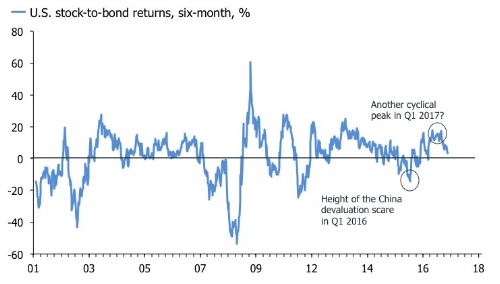
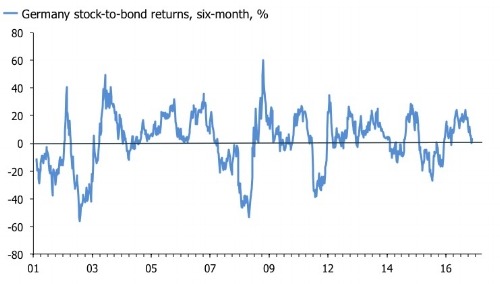
Deteriorating market health is another theme that has captured punters' attention over the summer. I have seen dozens of charts—mainly on U.S. equities—all of which broadly show that breadth has slipped to dangerous levels. My homegrown indicators support this story. The first chart below shows that 52-week net new highs, on the S&P 500, dipped below zero recently. The interpretation of this signal is pretty simple. It is a necessary, but not sufficient, condition for the market to have an accident. History suggests that if you must short the market, your chance of success is increased if you wait until breadth is deteriorating. The most recent history suggests that the S&P 500 will step back from the brink, but it's not looking pretty at the moment. By contrast, the second chart below shows that breadth on the Eurostoxx 50 appears to have turned a corner.
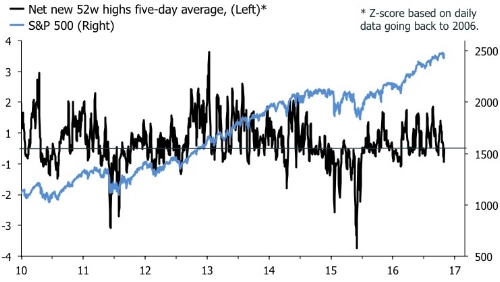
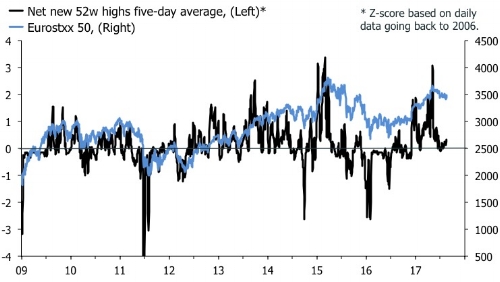
Valuations are another reason to worry about exposure to equities, but also one which continues to mock the cautious investor more than anything else. The only way to stay sane is to break the market down into sectors, which reveals a more nuanced picture. The first chart below breaks down the GICS 1 sectors on the MSCI World and offers up telecoms, energy and healthcare as the most attractive industries on a relatively basis. It also shows that financials remain attractively valued, despite solid trailing returns. Investors hoping for a return of the reflation trade will take comfort in this signal. Finally, the chart suggests that industrials, materials, and IT stocks are best avoided.
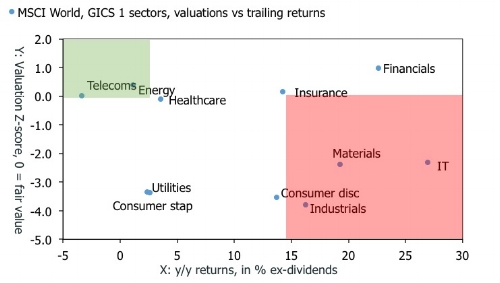
The portfolio is trying to exploit this message via positions in healthcare and telecoms stocks, but performance has stalled in the past few months. Indeed, I suspect that long-short investors are becoming tired by strategists' endless references to low volatility. It is certainly true that headline volatility is low, but for those of us with single stock exposure, earnings season has been a little too exciting at times. A couple of my friends and fund managers observed the following a few weeks back.
"It is funny with all this 'complacency', I had 2 stocks move > 20% yesterday (1 up, 1 down) and 6 moved > 4% (3 up, 3 down)"
"I had a similar experience yesterday with almost 10% moves in different directions. There is more volatility now at the stock level, even though at an index level, it appears to be cancelling out."
I am experiencing the same in my neck of the woods.
Plenty to worry about
The conclusion from my post-holiday overview is boringly familiar; a decent macroeconomic outlook and indifference to politics offer support for risk assets, but it isn't necessarily a reason to chase them higher. After all, equities and credit tend to price in better economic news ahead of the data. I think most would agree that a lot of the good news already is in the price. This implies that markets will be disappointed by even slight wobbles in the economic data. But the point I am getting at is more fundamental. If investors have nothing substantial to fear from the macroeconomic numbers and central banks will do anything not to rock the boat, the primary risk is that something snaps within markets, which feeds back into the economy driving a vicious circle for sentiment and asset prices. I will refrain from listing all my tin-foil hat theories here—most of you know all of them anyway—but as we move ahead in this mature bull market, it is fair to say that this risk probably is increasing at the margin. In a nutshell, the idea is that there is more to lose than to gain from sticking with a high exposure to risk assets at this juncture.
The problem with this assumption, however, is that investors have been fed warnings about crashes and recessions since late 2011. In the real world, however, asset prices have continued to grind higher. The notion that every dip is a buying opportunity is mocked by the bears. But they have contributed to this strategy's success by hailing every sign of weakness in markets as a harbinger of a recession or a crash. If you could have issued a confident warning on markets one year ago—and nothing happened—it's hard to take that same signal serious now. We need a shift in attitude and a catalyst for high valuations to suddenly become a reason for rapid outflows and indiscriminate selling. If we're lucky, we will know it when we see it, but anticipating one is risky business. Meanwhile, I am not scared of a quick 10%-to-20% crash. It would certainly be uncomfortable, but in the current environment also likely trigger a violent counter rally. The ugliest chart out there is the MSCI EM which trended down for six between 2010 and 2016. Even now, we can't be sure that its fortunes have turned. In a late-cycle market with plenty to worry about, it is a shift like that, which worries me the most.
Disclosure: None



